Occasional Cookie #2: Mostaccioli
A recipe for a spiced Christmas cookie with ancient origins and a confusing name

Welcome to Buona Domenica, a weekly newsletter of inspired Italian home cooking (and baking!). I’m Domenica Marchetti, journalist, cooking instructor, occasional tour guide, and author of eight cookbooks on Italian cuisine.
Before we move on to the newsletter:
This evening at the 92nd Street Y in New York City I will be in conversation with Giuseppe Dell’Anno, 2021 winner of the Great British Bake Off and author of two beautiful books on Italian baking. Join us live if you’re local, or online if you’re not. The event begins at 7 p.m. EST, but you can view it online for up to 72 hours afterwards. Join us ~ it’s going to be a fun and delicious conversation: https://www.92ny.org/event/giuseppe-dell-anno
I’ve added dates and details for my Fall 2024 culinary tour of Piemonte and Liguria. Find out more here.
This is the second in my Occasional Cookie series, which I started back in October. As I wrote in the inaugural post, “Cookies are one of life’s biggest small pleasures and we could all use more of them.” I realize that we have officially entered cookie season and so you are probably seeing lots of cookie recipes in your inbox and on social media. So I chose a cookie that is extra-special. And it comes with a good story.
This week’s post and recipe are free to all subscribers. Enjoy! Please help me grow this community of Italian food lovers by clicking on the green ‘Share Buona Domenica’ button below. And if you are a free subscriber, consider upgrading to a paid subscription, which gives you full access to all archived recipes, plus participation in giveaways (I’ve got a good one coming up), discounts for online cooking classes, and other perks. Grazie!
Years ago, when I was a beat reporter in suburban Detroit—Mount Clemens, MI, to be precise—my office mate Tom and I would pop in for lunch at a place called Broadway Cafe. It was a garden variety diner with a large, eclectic menu that listed everything from omelets to meatloaf, and from salads (Caesar, Cobb, etc) to spaghetti.
There was an item on the menu called “mostaccioli” that my friend sometimes ordered. It was a baked pasta dish made with penne, meat sauce, and lots of cheese. Which totally confused me because in my world, mostaccioli were spiced, chocolate-glazed Christmas cookies from my family’s region of Abruzzo. I didn’t particularly care for them, as they had orange zest and nuts and minced candied fruit, and in those days I preferred plain vanilla-iced gingerbread and sugar cookies. But…mostaccioli pasta? This Jersey girl had never heard of this Midwestern misnomer. However, my non-Italian husband, a native Michigander, confirmed to me that “mostaccioli” definitely meant baked pasta.
Time passed, I left Mount Clemens and beat reporting behind, and I did not think about mostaccioli—the pasta or the cookies—for years. In 2015, while I was working on my book Preserving Italy, I developed a recipe for mosto cotto, which is the fresh-pressed juice of wine grapes (grape must), cooked down into syrup. In Emilia-Romagna it’s called saba. In the days before sugar was common or affordable, this dark, fruity syrup was used to sweeten cakes and cookies. Many people still make it during the grape harvest, slowly boiling the grape juice down to a purple-brown syrup. In Abruzzo it’s made from the must of Montepulciano grapes. I had tasted it drizzled over fresh ricotta cheese at my friend Marta’s bed and breakfast in Sulmona and wanted to include a recipe in the book.
My research revived my interest in mostaccioli, the cookies (fyi the word ‘mostaccioli’ is plural; ‘mostacciolo’ is the singular term). I learned that mosto cotto was a key ingredient in these diamond- or rhombus-shaped cookies; hence their name. They are not exclusive to Abruzzo—cookies don’t typically respect borders. Molise, Campania, Puglia, Calabria, Sardegna, Sicily, even Lombardy in the north, all have traditional recipes for mostaccioli. The cookie apparently dates back to Roman times, when, according to this article in La Cucina Italiana, it was offered to departing guests. The article notes that “mustacei” were first described in Cato the Elder’s De Agri Cultura, his treatise on Roman agriculture:
Soak a bushel of flour with the must, add anise, cumin, two pounds of fat, a pound of cheese and some bay bark, when you have kneaded it and given it the right shape, bake it on laurel leaves.
There are differences in the various regional recipes that survive. In parts of Puglia, fig syrup is used in place of mosto cotto, and in Calabria, the cookies are cut into symbolic animal or people shapes. For the most part, however, mostaccioli are either cut into diamonds or chunky little rhombuses and draped with a chocolate glaze.
And what of mostaccioli, the pasta? I finally reached out to a source I was unable to turn to back in the 1990s—Google. I conducted a little experiment. First, I googled just the word ‘mostaccioli’ and clicked on ‘images,’ and lo and behold, up came dozens of pics and recipes for the same gooey baked pasta dish I had encountered all those years ago in Mount Clemens, MI. Not a cookie in sight:
Notably, none of these recipes came from Italian sources, but rather websites like Food Network and Taste of Home, and popular blogs with names like “Spend With Pennies,” “Delish,” and “I Heart Naptime.” A lot of the recipes appear to be recent, within the last year or two, so it appears that mostaccioli the pasta is still popular, or newly popular.
When I changed the search by adding the word, “ricetta” (Italian for ‘recipe’) in front of the word “mostaccioli,” the view was entirely different:
It’s no mystery, really. The typical shape used to make baked pasta in southern Italy, especially the region of Campania, is penne lisce—smooth penne. The rhombus shape, with its pointed ends, is reminiscent of the shape of mostaccioli cookies. At some point, the pasta adopted the name of the cookie. Barilla actually markets its ‘penne lisce’ as mostaccioli in the U.S. I’d just never heard it called that. My Italian-American father, who grew up in Rhode Island—his mom was from Molise and his dad from Lazio)—called penne lisce “pencil points,” which is still my favorite name for them.
I don’t have a specific recipe for mostaccioli pasta, so here’s a recipe for really good rigatoni al forno that I posted last December. (Also, a friendly reminder that that you can access all Buona Domenica recipes via the recipe index here.)
I do enjoy going down these little rabbit holes trying to untangle seemingly confusing Italian food terms. For those of you who are familiar with the word ‘mostaccioli,’ I’m curious to know whether you associate it with cookies or with baked pasta.
Back to the cookies; after all, it is cookie season. The recipe I’m sharing below is the one I came up with for Preserving Italy, and while it contains no bay bark or cheese (I hope you’re not disappointed), it does have plenty of spice and a lovely fruit undertone, thanks to the mosto cotto. I wrote at length about this somewhat magical condiment in the book. Left to age for a period of weeks to months (or longer), the syrup mellows in flavor and takes on notes of prune, raisin, fig, cherry, and spice. It can be used in both sweet and savory dishes. Somewhere I have a recipe for veal meatballs with peppers and mosto cotto, which I’ll dig up and share one of these days. In addition to flavor, the syrup gives the cookies a slightly chewy, cake-like crumb. See below for suggestions for mosto cotto substitutes.
RECIPE: Mostaccioli (cookies)
Numerous Italian regions—Abruzzo, Basilicata, Campania, and Puglia among them—lay claim to a spiced Christmas cookie that goes by the name mostaccioli (pronounced ‘moh-stah-CHO-lee’). One of my old Italian baking books contains 13 different recipes, with one version hailing from Alto Adige, in the far north of Italy, and another from Sicily.
While the recipes vary in ingredients, as well as shaping and baking methods, one thing almost all of them have in common is that they are usually diamond- or rhombus-shaped. Another common characteristic is that the dough typically contains nuts and a mix of spices, especially cinnamon and clove. And, in the days before sugar was a common ingredient, the dough was sweetened with mosto cotto, grape must syrup, which is where the cookie is believed to have gotten its name.
Many modern recipes replace the mosto cotto with runny honey. The online purveyor Gustiamo sells saba, the Emilia-Romagna equivalent of mosto cotto. You can also substitute date syrup or fig syrup.
Makes about 3 dozen cookies
INGREDIENTS
1/2 cup (70 g) raw skin-on almonds
3 cups (390 g) unbleached all-purpose flour, plus more for dusting the work surface
1 cup (200 g) sugar
2 tablespoons unsweetened cocoa powder
1 teaspoon baking powder
1 teaspoon ground cinnamon
1/4 teaspoon ground cloves
3/4 cup (300 g) mosto cotto, saba, date syrup, fig syrup, or runny honey
2 large eggs, lightly beaten
1 pound (454 g) bittersweet chocolate, for glazing
2 tablespoons sunflower oil or other neutral oil
Candied orange peel, sprinkles, or other decorations (optional)
INSTRUCTIONS
1. Preheat the oven to 350° F (180° C) and line two rimmed baking sheets with parchment.
2. Spread the nuts on a small, rimmed pan (I use a small pizza pan) and bake until they are fragrant and start to crackle, 7 to 8 minutes. Remove them from the oven and let cool completely. (You can leave the oven on or turn it off and then reheat it while the dough rests.)
3. Grind the cooled almonds in a food processor until finely chopped. Add the flour, sugar, cocoa powder, baking powder, cinnamon, and cloves to the work bowl of the processor and pulse until everything is well combined. Using the feed tube, pulse in the mosto cotto and eggs and mix until a soft ball of dough forms.
4. Gather the dough onto a lightly floured surface, knead it briefly, and pat it into a disk. It may not be completely smooth; this is fine. Cover tightly with wrap and let it rest at room temperature for 30 to 60 minutes. If you turned off the oven, turn it back on to 350° F (380° C).
5. Turn the dough out onto a lightly floured surface and roll it into a rough rectangle about 1 cm thick (slightly less than 1/2 inch). With a diamond cookie cutter, a sharp knife, or a pastry roller, cut the dough into diamond shapes about 2 inches wide and 3 inches long (5 x 7.6 cm). Gather up any scraps and re-roll them to make more mostaccioli. You should end up with about 36.
6. Place the mostaccioli 1/2 inch (1 cm) apart on the parchment-lined baking sheets. Bake, one sheet at a time, until the cookies are set and lightly crackled on the surface, about 15 minutes. Let them cool on the sheets for 10 minutes, then transfer them to racks to cool completely.
7. To temper the chocolate for glazing: Coarsely chop 12 ounces (340 g) of the chocolate and leave the rest in larger pieces. Put the chopped pieces in a heat-proof bowl and set it over a pan of barely simmering water, taking care that the bottom of the bowl does not come in contact with the water. Slowly melt the chocolate, stirring occasionally. Remove the bowl from the pan of simmering water and wipe the bottom to prevent any water from coming into contact with the chocolate. Stir in the remaining chocolate and the oil and continue to stir until all of the chocolate has melted. Use an instant-read thermometer to check the temperature of the chocolate. It will stay glossy without any white streaking if the temperature is between 86° and 90° F when the cookies are dipped.
8. Have ready two baking sheets lined with parchment (I use the same parchment on which the cookies were baked). Dip the tops of the mostaccioli into the bowl of melted chocolate, allowing the excess to drip back into the bowl. Set the cookies on the baking sheets and let the chocolate set completely, about 1 hour, before serving. If you would like to make them look even more festive, you can sprinkle decorations on them right after dipping, or garnish them with a piece of candied orange peel.
Store the mostaccioli in an airtight tin. To prevent scuffing, arrange the cookies in layers, with sheets of waxed paper or parchment between them. The mostaccioli will keep for up to a week.
As always, thank you for reading, subscribing, and sharing.
Alla prossima,
Domenica

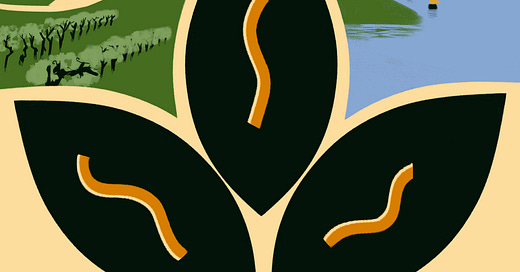


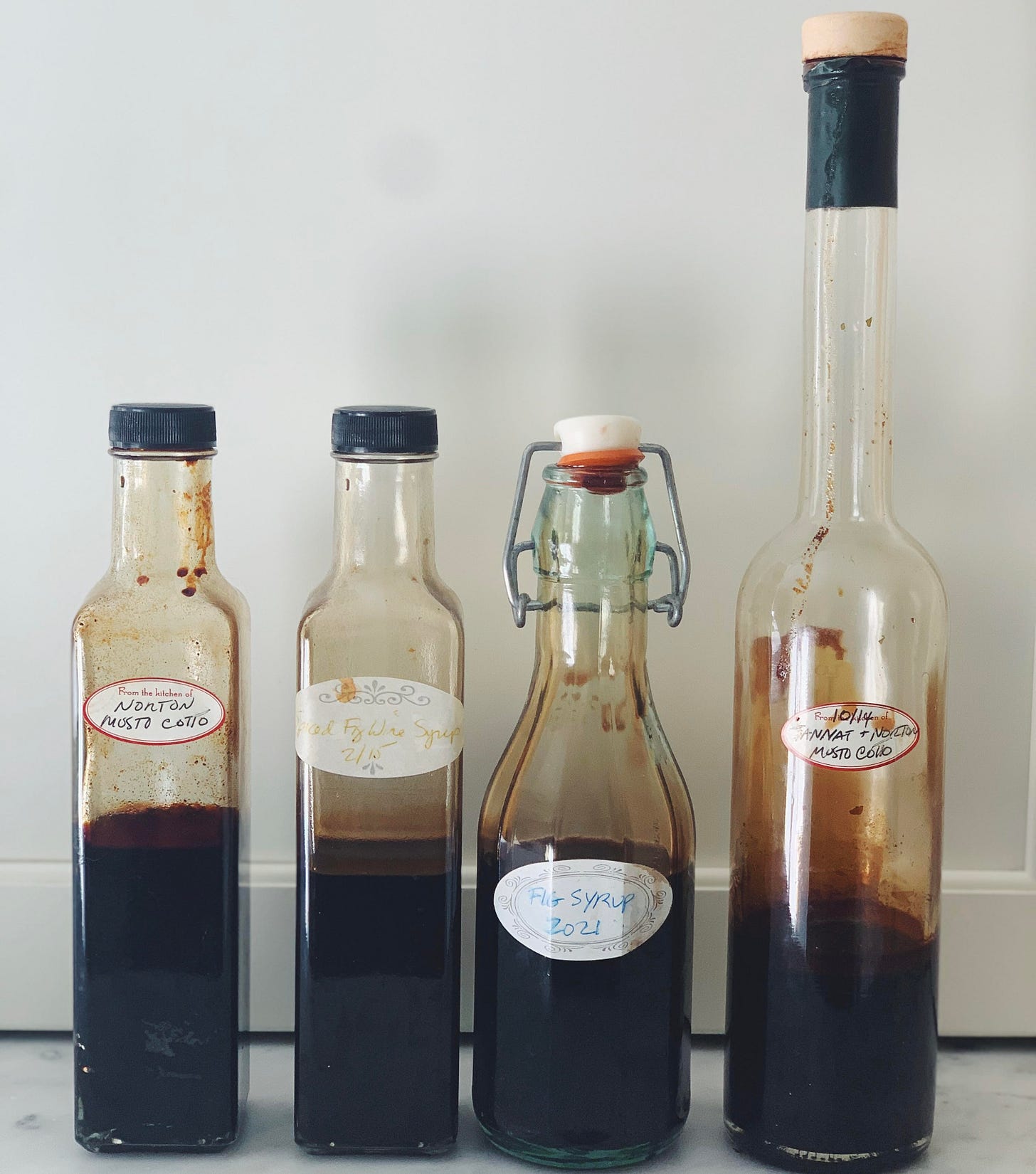
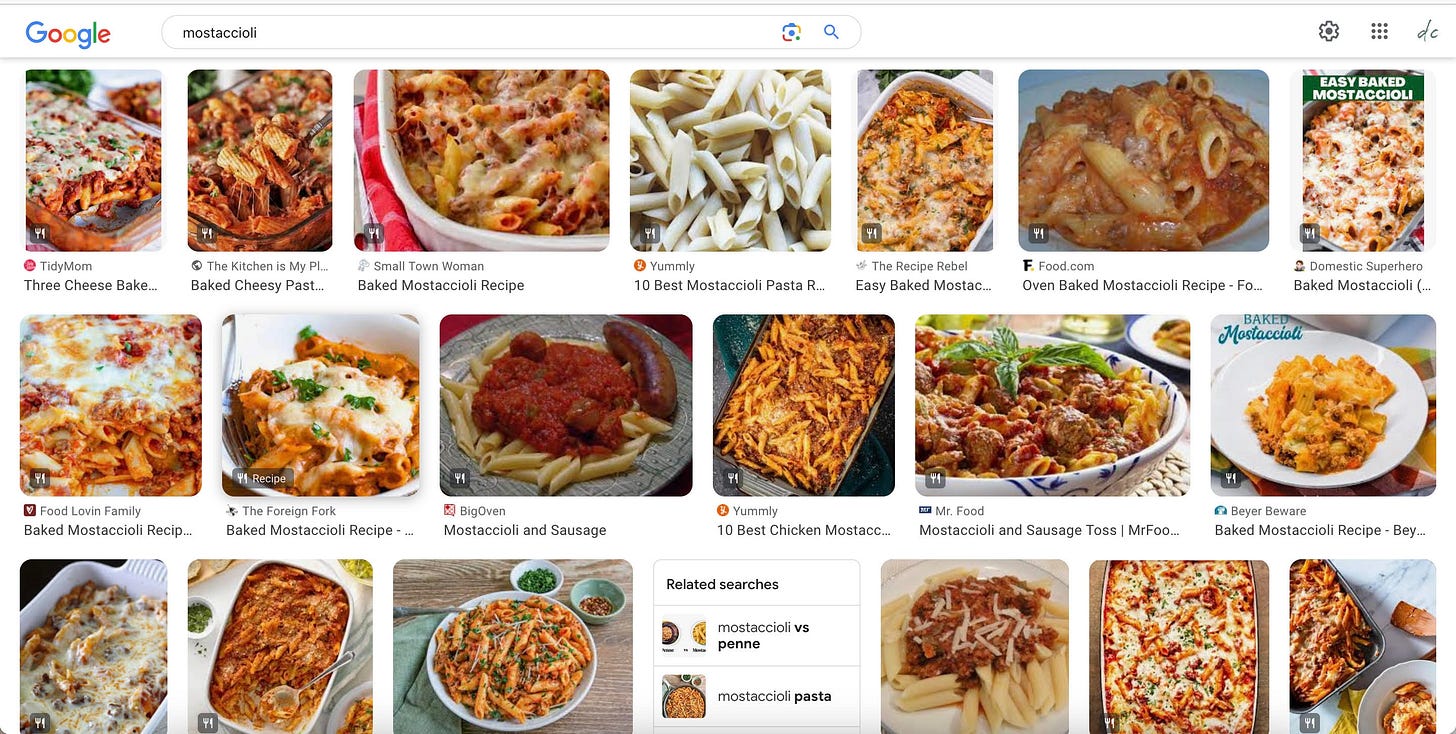
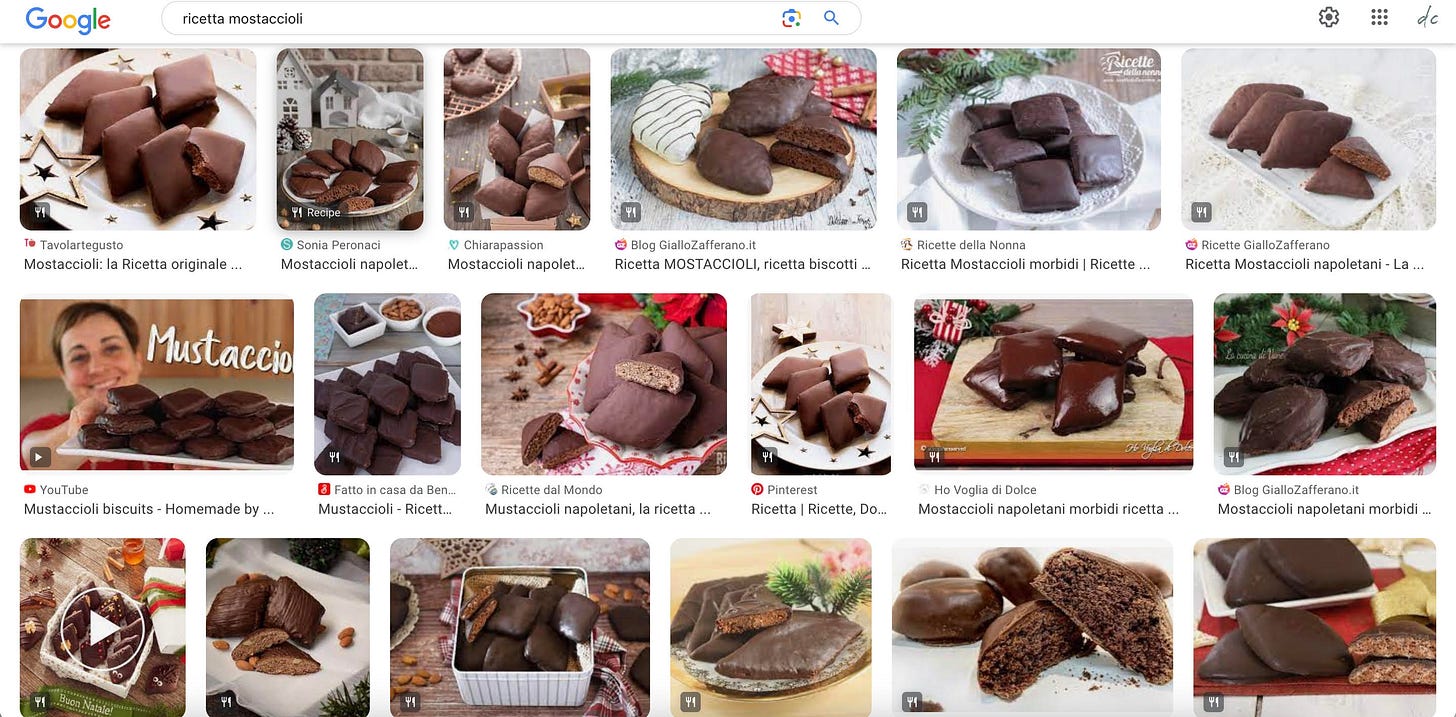
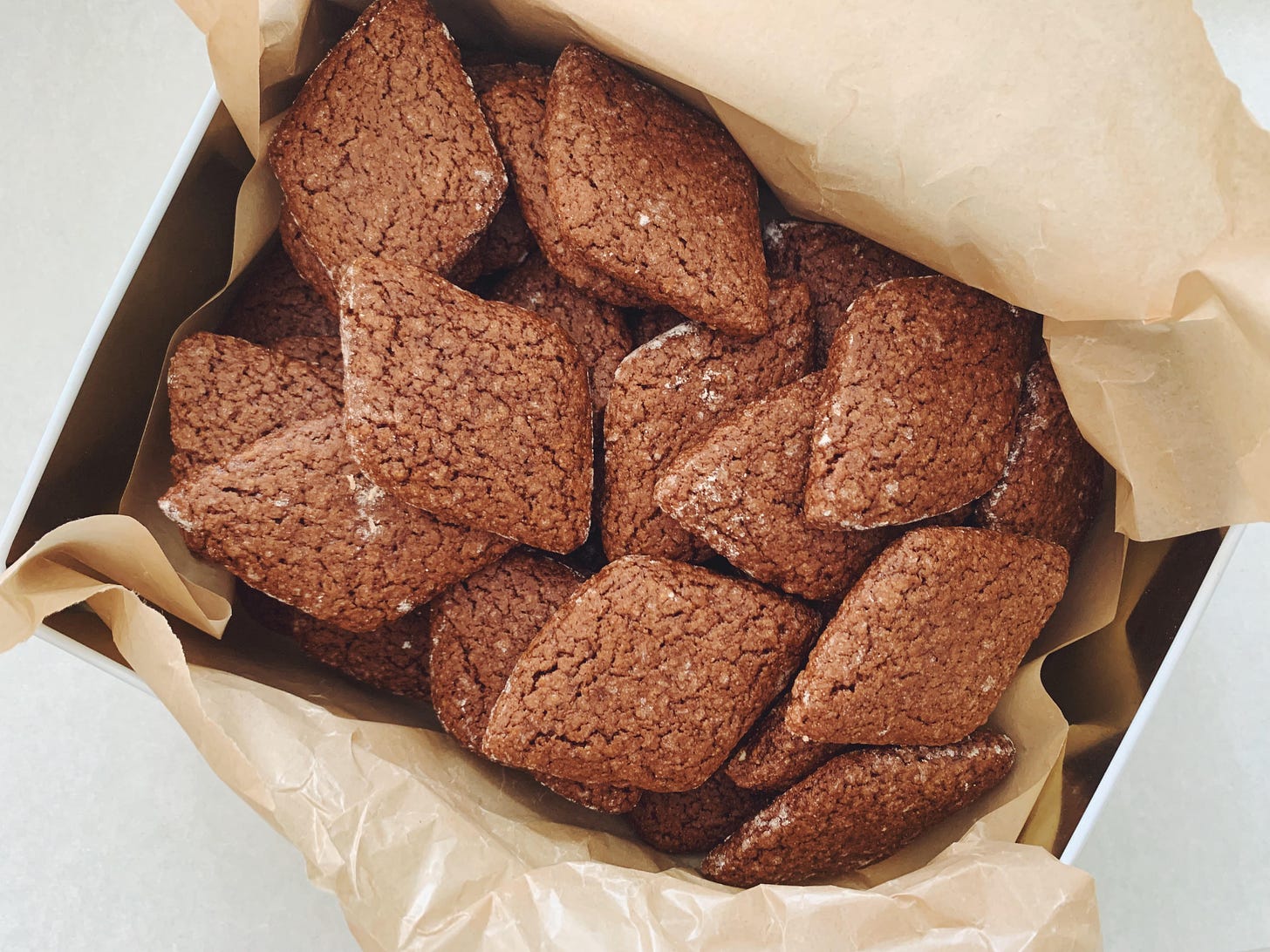
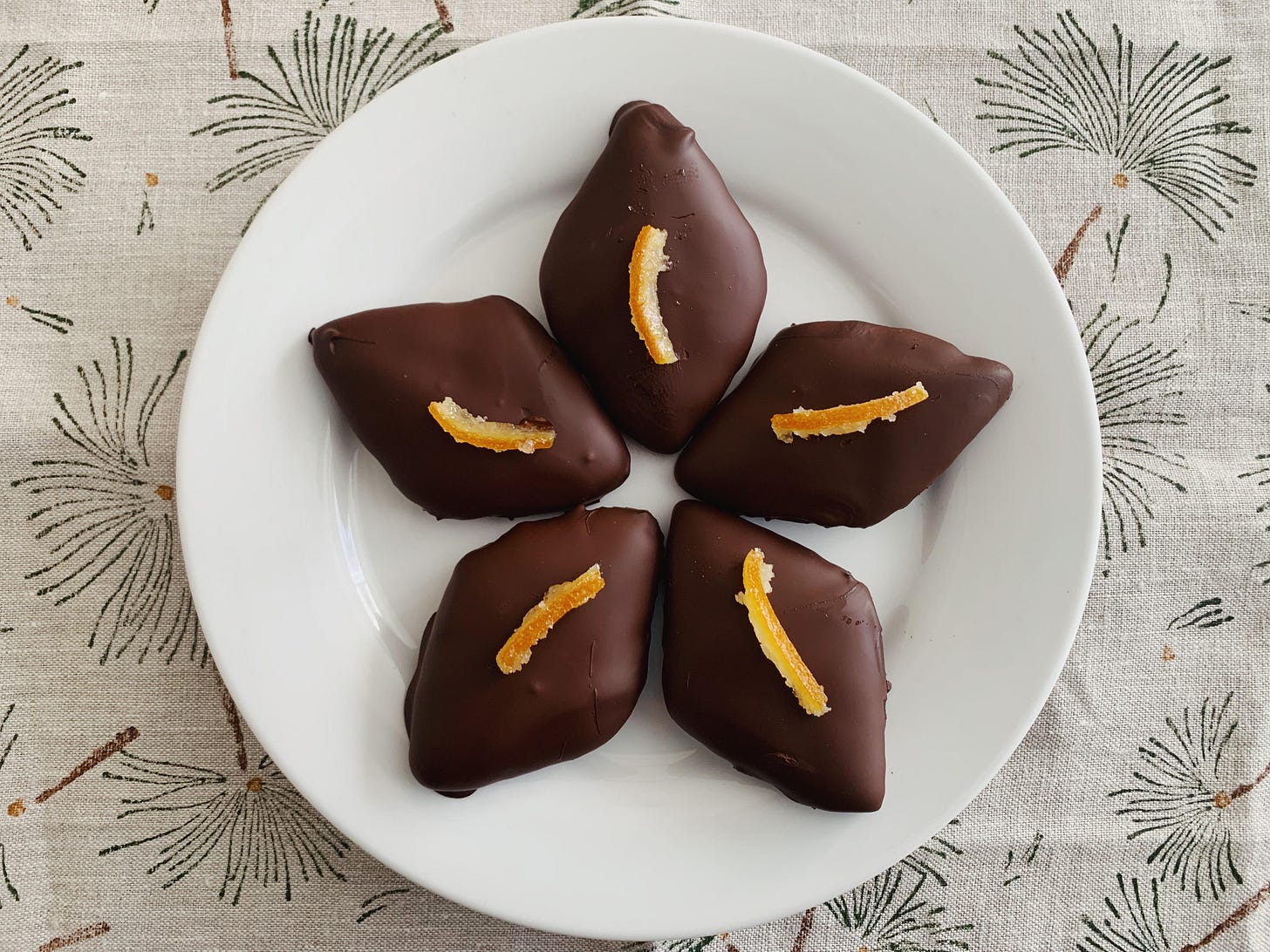
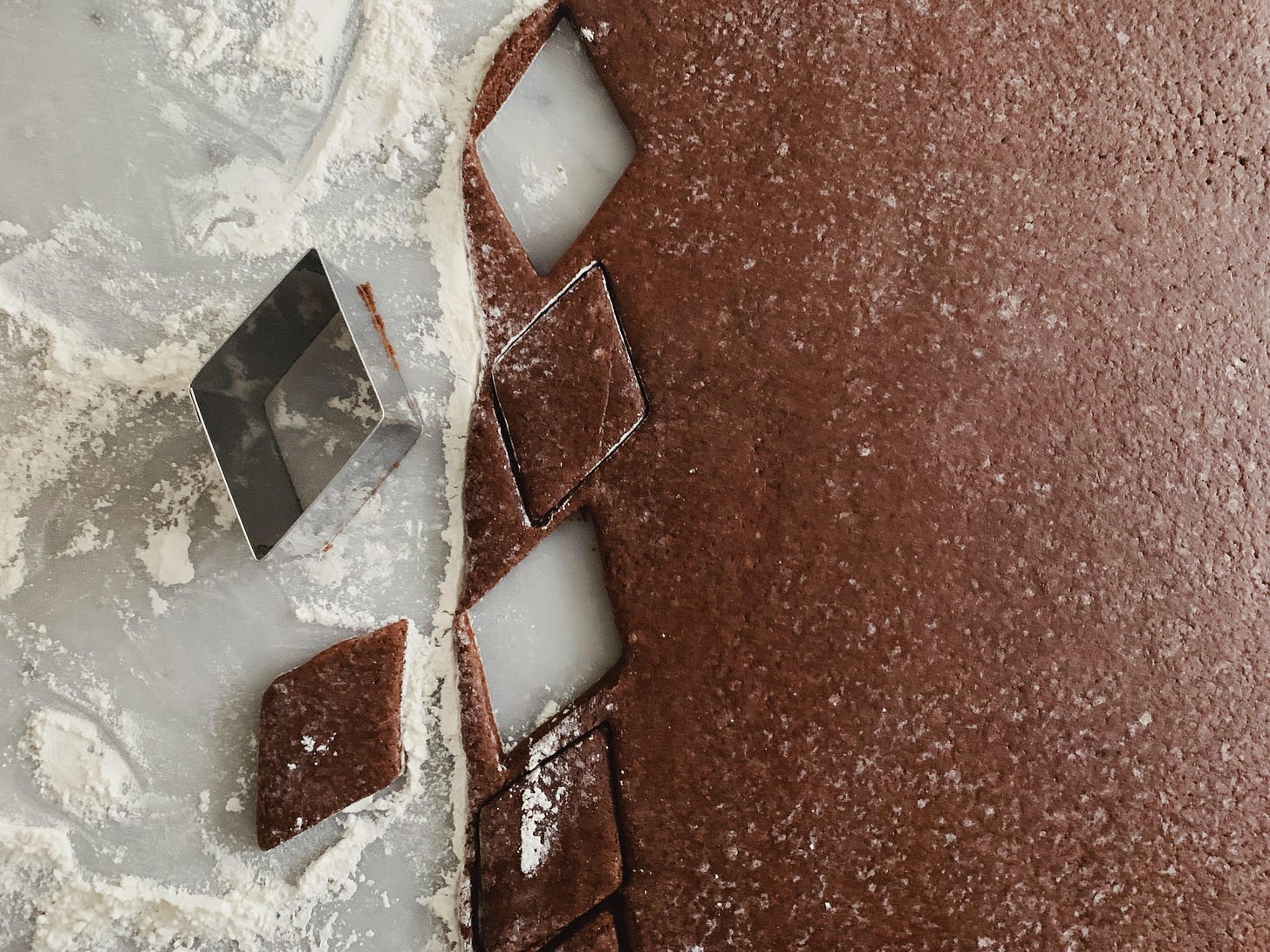
The guide Katy was talking with said there 2 or 3 panetterie in Assisi where you could still find
Mostaccioli. They must have been brought up from Abruzzo. Sounded interesting!
An appealing recipe and interesting tale.